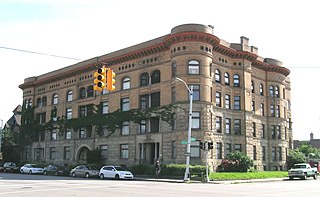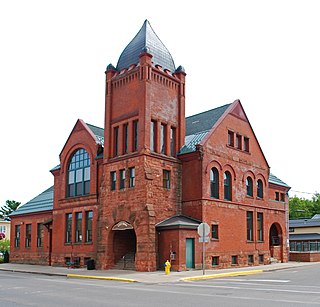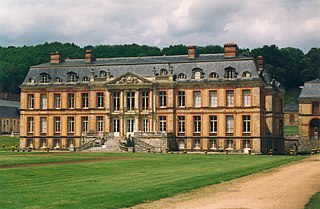
Jackson is a historic Amtrak station in Jackson, Michigan, United States. It is served by the Wolverine. The station was added to the National Register of Historic Places in 2002.

The Detroit–Columbia Central Office Building is a building located at 52 Selden Street in Midtown Detroit, Michigan. It is also known as the Michigan Bell Telephone Exchange. The building was listed on the National Register of Historic Places in 1997.

The Coronado Apartments are an apartment building located on 3751–73 Second Avenue in Midtown Detroit, Michigan. It was designated a Michigan State Historic Site in 1980 and listed on the National Register of Historic Places in 1982.

The Frederick Stearns Building is a manufacturing plant located at 6533 East Jefferson Avenue in Detroit, Michigan. The building was listed on the National Register of Historic Places in 1980 and designated a Michigan State Historic Site in 1981. It has been converted to condominiums.

The Lake Linden Village Hall and Fire Station is a public building, located at 401 Calumet Avenue in the Lake Linden Historic District in Lake Linden, Michigan.

The Hancock Town Hall and Fire Hall is a public building located at 399 Quincy Street in the Quincy Street Historic District in Hancock, Michigan. It is also known as the Hancock City Hall. It was designated a Michigan State Historic Site in 1977 and was listed on the National Register of Historic Places in 1981.

The Savings Bank Building is a commercial building located at 101 South Front Street in Marquette, Michigan. It is also known as the Marquette County Savings Bank. The building was designated a Michigan State Historic Site in 1976 and listed on the National Register of Historic Places in 1978.

The Longyear Building is a commercial structure located at 210 North Front Street in Marquette, Michigan. It was listed on the National Register of Historic Places in 2004.

The Harlow Block is a commercial building located at 100 West Washington Street in Marquette, Michigan. It was listed on the National Register of Historic Places in 1983.

The Ishpeming Municipal Building is a public building located at 100 East Division Street in Ishpeming, Michigan. It is also known as Ishpeming City Hall. The building was designated a Michigan State Historic Site in 1980 and listed on the National Register of Historic Places in 1981.

The Clark Memorial Hall, also known as the Adrian I.O.O.F. Hall, is a commercial building located at 120–124 South Winter Street (M-52) in the Downtown Adrian Commercial Historic District in Adrian, Michigan. It was designated as a Michigan Historic Site and individually listed on the National Register of Historic Places on January 14, 1985.

The Hudson Downtown Historic District is a historic district comprising the downtown area of the city of Hudson in westernmost Lenawee County, Michigan. It was designated as a Michigan Historic Site on January 21, 1974. It was later added to the National Register of Historic Places on December 24, 1974.

The Houghton County Courthouse is a government building located at 401 E. Houghton Street in Houghton, Michigan. It was designated a Michigan State Historic Site in 1974 and placed on the National Register of Historic Places in 1975.

The Marquette County Courthouse is a government building located at 400 South 3rd Street in Marquette, Michigan. It designated a Michigan State Historic Site in 1976 and was listed on the National Register of Historic Places in 1978. The courthouse was the setting of the 1959 film Anatomy of a Murder, directed by Otto Preminger.

The Ironwood City Hall was a government building located at the corner of McLeod Avenue and Norfolk Street in Ironwood, Michigan. It was listed on the National Register of Historic Places in 1980, designated a Michigan State Historic Site in 1975, and demolished in 1989.

The Old Cadillac City Hall is a government building located at 201 Mitchell Street in Cadillac, Michigan. It was designated a Michigan State Historic Site in 1983 and listed on the National Register of Historic Places in 1986.

The Iron Mountain Central Historic District is a historic district, broadly located between Fleshiem and C Streets and between Iron Mountain and Stockbridge Avenues in Iron Mountain, Michigan. The district covers the city's central business district and adjacent areas. It is primarily commercial, but also contains the historic county courthouse complex, and school, library, and church buildings. It was listed on the National Register of Historic Places in 2013.

The I.O.O.F. Centennial Building is an historic building located at 150 East Chisholm Street in Alpena, Michigan. It was listed on the National Register of Historic Places in 2015. It dates back to 1876 and is “an excellent example of late Victorian commercial architecture.”

The Braastad–Gossard Building, also known as the Gossard Building or Pioneer Square, is a commercial building located at 308 Cleveland Avenue in Ishpeming, Michigan. It was listed on the National Register of Historic Places in 2015.

The Bay City Station of the Pere Marquette Railway, also known as The Depot Building, is a former railroad depot located at 919 Boutell Place in Bay City, Michigan. It was listed on the National Register of Historic Places in 1982.






























